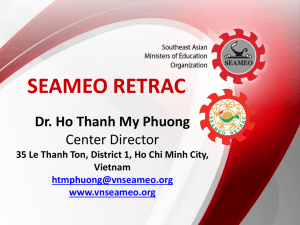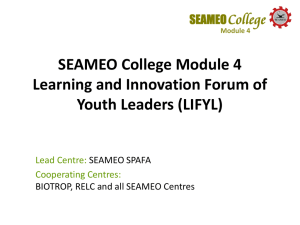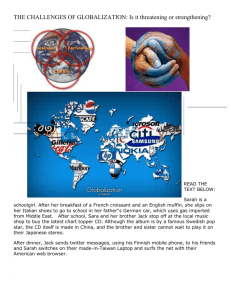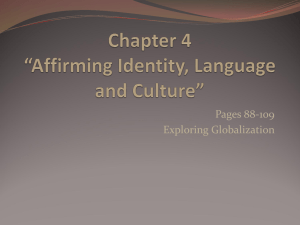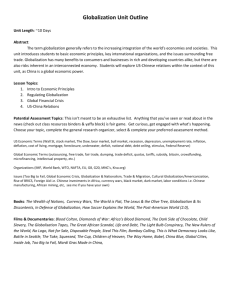Speech
advertisement
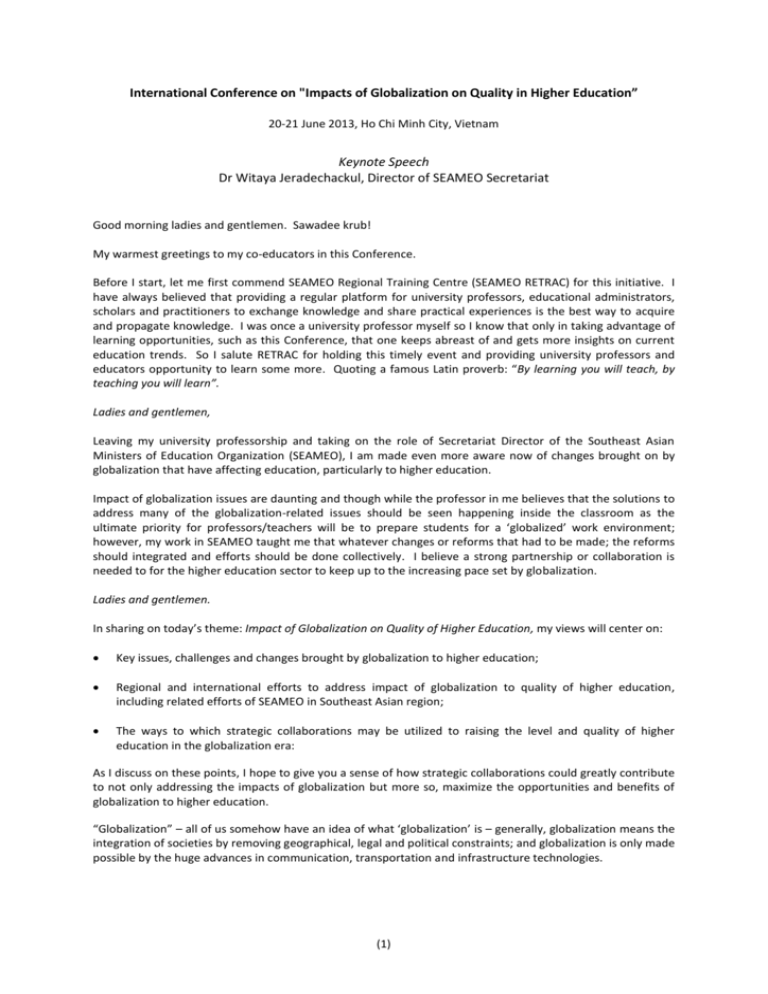
International Conference on "Impacts of Globalization on Quality in Higher Education” 20-21 June 2013, Ho Chi Minh City, Vietnam Keynote Speech Dr Witaya Jeradechackul, Director of SEAMEO Secretariat Good morning ladies and gentlemen. Sawadee krub! My warmest greetings to my co-educators in this Conference. Before I start, let me first commend SEAMEO Regional Training Centre (SEAMEO RETRAC) for this initiative. I have always believed that providing a regular platform for university professors, educational administrators, scholars and practitioners to exchange knowledge and share practical experiences is the best way to acquire and propagate knowledge. I was once a university professor myself so I know that only in taking advantage of learning opportunities, such as this Conference, that one keeps abreast of and gets more insights on current education trends. So I salute RETRAC for holding this timely event and providing university professors and educators opportunity to learn some more. Quoting a famous Latin proverb: “By learning you will teach, by teaching you will learn”. Ladies and gentlemen, Leaving my university professorship and taking on the role of Secretariat Director of the Southeast Asian Ministers of Education Organization (SEAMEO), I am made even more aware now of changes brought on by globalization that have affecting education, particularly to higher education. Impact of globalization issues are daunting and though while the professor in me believes that the solutions to address many of the globalization-related issues should be seen happening inside the classroom as the ultimate priority for professors/teachers will be to prepare students for a ‘globalized’ work environment; however, my work in SEAMEO taught me that whatever changes or reforms that had to be made; the reforms should integrated and efforts should be done collectively. I believe a strong partnership or collaboration is needed to for the higher education sector to keep up to the increasing pace set by globalization. Ladies and gentlemen. In sharing on today’s theme: Impact of Globalization on Quality of Higher Education, my views will center on: Key issues, challenges and changes brought by globalization to higher education; Regional and international efforts to address impact of globalization to quality of higher education, including related efforts of SEAMEO in Southeast Asian region; The ways to which strategic collaborations may be utilized to raising the level and quality of higher education in the globalization era: As I discuss on these points, I hope to give you a sense of how strategic collaborations could greatly contribute to not only addressing the impacts of globalization but more so, maximize the opportunities and benefits of globalization to higher education. “Globalization” – all of us somehow have an idea of what ‘globalization’ is – generally, globalization means the integration of societies by removing geographical, legal and political constraints; and globalization is only made possible by the huge advances in communication, transportation and infrastructure technologies. (1) However, the meaning of globalization or connotation, over time, is evolving and is now an ubiquitous term but however, you defined it; globalization, as well as technological advancements is effecting changes within learning systems across the world – changing ideas, values, knowledge, changing the roles of students and teachers, effecting change on culture, re-shaping of norms and cultural identities. Lastly, globalization is changing the economic environment, dictating new market trends and labor demands. Globalization has great impact in the context of higher education. Let me only highlight on a few of the key issues, challenges and changes brought on by globalization that I think has significant bearing in relation to higher education: Globalization is making education even more invaluable to individuals. In such a competitive global environment, increasingly, individuals recognize that education provides for better chance of employment, which in turn will provide them with higher status in life. Globalization is making English Language a requisite education and business tool. With English as “global language”, individuals around the world are now striving to learn English to function on a ‘global scale’. Increasing need for English language teaching and learning poses significant pressure to higher education institutions. Globalization is setting global standards on education. Higher education institutions are compelled to examine long-standing policies and practices in the light of international standards and demand for quality education. Traditional classroom delivery mode has now now shifted to a transnational means of provision of higher education service such virtual/e-learning or open universities, consortium arrangement and others. To be able to participate to international exchange programmes and recognition of qualifications, higher education institutions have to comply to quality assurance standards. Likewise, the need for the higher education institutions to develop internationally comparable curriculum, contents, and delivery system that help students to develop international and intercultural skills. Globalization causes ever-changing shift and trends in labor and employment. With globalization comes changing shifting patters on market and labour demands, higher education institutions are made aware that their policies and priorities should constantly align to employment needs. Globalization dynamics requires workforce that can compete internationally. Oftentimes, higher educations fail to meet the needs for the kinds of workers ‘globalized’ economy requires. Globalization is posing challenges to cultural values and identity. Apart from knowledge acquisition, higher education is also mandated to facilitate cultural preservation; but as higher education becomes more specialized and curricula were customized to fit the globally recognized standard courses and programs, cultural values, traditions and identity are left out in the process. There are a lot more scholarly discourse on the issues of globalization and higher education; and possibly, in this Conference, you will get to learn some more of these issues. In academic circle, the impact of globalization to higher education has ensued numerous discussions and debates. I must admit that the issues I cited here are only a fraction of many other dimensions of the impact of globalization on higher education. In presenting these selected key issues, my intention is not to dig deeper into these issues to add to the existing body of scholarly discourse but instead just to argue the point that globalization is changing the landscape of higher education; and that these changes will continually put pressure to higher education system. Importantly, I want to emphasize that these issues and changes brought by globalization should not necessarily be taken as ‘risks’ or ‘disadvantages’. As I will discuss later, these changes can actually be benefits that education sector should be maximizing. In fact, globalization could be most instrumental in raising the level and quality of higher education. (2) Numerous initiatives and platforms have been initiated at the international and regional arena in an effort to respond to issues and challenges confronting higher education as a result of globalization. Just to cite a few: The Bologna Process (a series of ministerial meetings and agreements between European countries designed to ensure comparability in the standards and quality of higher education qualifications) which created the European Higher Education Area (EHEA) which is meant to ensure more comparable, compatible and coherent systems of higher education in Europe; The Global Forum on International Quality Assurance, Accreditation and the Recognition of Qualifications, launched by UNESCO, aims to provide a platform for dialogue between a wide range of higher education providers and stakeholders and to link existing frameworks dealing with international issues of quality assurance, accreditation and the recognition of qualifications; Global Initiative for Quality Assurance Capacity (GIQAC) by World Bank and UNESCO, is a programme to support higher education institutions in developing countries in enhancing quality assurance systems and building their capacity by sharing information on good practices on Higher education world-wide; The ASEAN University Network (AUN) developed the AUN Quality Assurance Guidelines which sets out standards and criteria that are meant to serve as benchmark standards to be used by the universities in ASEAN to see how far they are on track towards quality and quality assurance; I am pretty sure that all of you are mostly familiar with these initiatives; and there are more ongoing efforts related to quality assurance and harmonization of standards in higher education. I will focus though on what SEAMEO has done so far and is currently doing on upgrading quality of higher education and education in general in the region. Ladies and gentlemen, One of the strategic goals of SEAMEO is to strengthen the organizational capability to initiate and manage change and development to meet the challenges of globalization. SEAMEO’s strength lies on its ability to establish and sustain partnerships and collaborations with different international, regional organizations and development partners. EU, UNESCO, AUN and ASEAN Secretariat are major partners of SEAMEO. As such, SEAMEO’s initiatives on higher education are aligned to key efforts of international and regional community. In addition, SEAMEO banks on its use of foresight methodologies to support the designing of relevant education programmes. SEAMEO works by surveying current trends and gaps; analyze demands and identify future needs; and accordingly, design our education programmes to meet the exact need. SEAMEO’s approach is to look into the multiple aspects of the educational system and use an integrated approach in designing programmes. The following are some of SEAMEO’s flagship initiatives mainly aimed at making higher education in Southeast Asia at par with global education standards: Creating a regional platform, regional system that is adaptive, innovative and responsive to emerging, trans-boundary regional issues on education through the SEAMEO College: Creation of an improved and more effective education system (primary, secondary and higher education) will enable the countries in the region to better respond to the demands of globalization in terms of: (1) producing graduates whose skills and knowledge the demands of the labor market; and (2) in facilitation mobility of students, skilled workers and professionals within Southeast Asia and beyond. Various reports and documents state that in the Southeast Asian region, the countries face varying problems with regard to mismatch between manpower skills and labor or industry demands. Knowledge and skills of higher education graduates does not meet with the demands and requirements of the labor force. The problem is aggravated by the scarcity of manpower market studies or manpower supply- (3) demand gap studies that would have been able to identify future industry needs in terms of manpower competencies. SEAMEO intends to contribute towards addressing this issue by its plan to provide a regional platform that will offer human resource development initiatives designed as a result of manpower demand forecasts or labor supply-demand gap studies, foresight exercises and case studies. This regional platform is what we call ‘SEAMEO College’, to be implemented by SEAMEO Centres and coordinated by the SEAMEO Secretariat SEAMEO’s Initiatives on Harmonization Process. Since the mid-2007, SEAMEO, through SEAMEO RIHED has started the project to raise the awareness among key players in higher education sector within the region on the significance of promoting a common space in higher education in Southeast Asia. o A Structured Framework for Regional Integration in Higher Education in Southeast Asia: The Road Towards a Common Space” (2008-2014), was initiated with the main objective of raising awareness of policy makers and high ranking officials in SEAMEO Member Countries on the significance of an inter-governmental process leading to a regional framework for higher education integration and harmonization and to help facilitate future establishment of ‘a common space in higher education” in Southeast Asia by 2015; o Raising Awareness: Exploring the Ideas of Creating Higher Education Common Space in Southeast Asia. With the intention of initiating efforts towards development of a version of Europe Higher Education Area (EHEA) in the Southeast Asian region, SEAMEO RIHED launched a conference series to trigger discussions on the creation of a regional higher education area/space to facilitate and enhance better cooperation among individuals and higher education institutions in Southeast Asia. Ensuring the alignment of efforts on basic education and higher education. Considering the current and future dynamics of globalization on education, SEAMEO recognizes the significance of ensuring the alignment of basic education sector with higher education. To this end, SEAMEO while focusing on development of higher education likewise gives equal priority to building the national government’s capacities in terms of educational innovation and educational management of basic education system. Through the SEAMEO Regional Centre for Educational Innovation and Technology (SEAMEO INNOTECH), SEAMEO has been implementing a variety of proven innovations aimed at enhancing the capacities of education leaders and school administrators on education management leadership, school management and curriculum supervision. Ensuring that these teaching-learning technologies (both at the basic education and higher education) integrate and promote preservation of cultural identities and national values. SEAMEO through SEAMEO Regional Language Centre (RELC) is promoting English language learning to enhance work Competence and facilitate cultural understanding through its English Proficiency Courses for nurses, health workers and government officials. The aim is towards developing oral interaction competencies to facilitate better work performance. The English Communication Skills Course for Cultural Awareness develops competence in oral interaction with people from other cultural backgrounds to promote cultural understanding. Ladies and gentlemen, The overarching issue here is how the countries in the region (and in the world) are moving towards addressing the resulting effects of globalization to higher education by mainly creating a common space that will facilitate and enhance better cooperation among individuals and higher education institutions in Southeast Asia. To quote Prof Dr Supachai Yavaprabhas, former SEAMEO RIHED Director, in his paper SEAMEO RIHED and Higher Education Harmonization: “Many higher education institutions and national governments in many parts (4) of the world have already ventured on to tackle the force of globalisation by reforming their higher institutional structure as well as embarked on regional effort in establishing a common framework for higher education”. But the concerning issue here is the extent to which the national governments and higher education institutions could adjust themselves to best counter issues brought about by globalization such as with transnational development and cross-border transition. Admittedly, only small number of higher education institutions in the region can offer flexible mobility programmes and mainly, national governments have not put as top priority initiatives related to higher education. It is pertaining to this specific point that I will now proceed to sharing some of my ideas on the ways to which strategic collaborations among the national governments, higher education institutions, international and regional institutions, higher education networks and business/industry sector may be utilized to raising the level and quality of higher education in the globalization era: Inter-governmental discussions and dialogues (such as that of SEAMEO College) to set out addressing common goals and concerns on higher education, including issues on harmonization across countries; Cooperation and knowledge sharing among national governments on higher education policies and strategies; Business or employment sector to be engaged in the discussions for policies to be more responsive to labor or manpower resource needs; National governments to provide regular platform for an increased interactions and sharing among their higher education institutions; and Importantly, efforts to build on mechanisms or initiatives on higher education already developed in other regions/countries (on the areas of standardization, quality assurance, mobility, credit transfer, accreditation) but to made in the context of the region; Ladies and gentlemen, My co-educators, professors, administrators, teachers, colleagues, I mentioned early on that amidst issues related to globalization and higher education, the priority goal should be to effectively prepare students for an economic and work environment that is increasingly becoming more complex and competitive. Collaboration, partnership, creation of strategic alliances is the way to pursue this goal. In fact, we can make globalization work towards this end. Collaborations will help facilitate the process of integration and harmonization of efforts on higher education – thus leveling the playing field for the development of higher education; students then will receive similar level and quality of higher education (wherever he/she is in the world); consequently, the students then would graduate having an equal opportunity for success in terms of employment. Undeniably, globalization and the international integration process alongside it is inevitably re-shaping the landscape of the region, economically, politically, socially and culturally. We can take advantage of this globalization/integration process though to strengthen intercultural understanding among countries. SEAMEO, as an organization that promotes regional cooperation on education, science and culture, we take pride in the Organization’s flexibility and resilience that has enabled us to meet the challenges posed by the fast changing development in the region. We, in SEAMEO, will be at the frontier, assisting the national governments, collaborating with key partners in the region and initiating concerted efforts to ensure that peoples of Southeast Asia thrive in this age of globalization. Thank you very much. Khob khun krub! (5)

